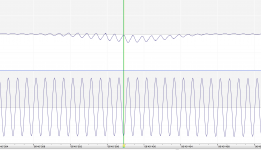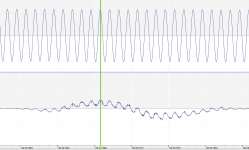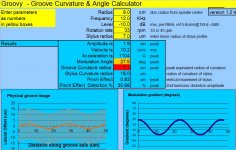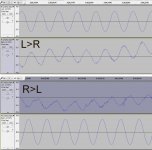When one thinks about it, for a sine test signal on one channel only, one groove wall is entirely plain, and the locus of the groove base has a 3D shape moving laterally and vertically so that effectively the stylus rides up and down the plain wall (as considered from the top) if all is tracing perfectly.
Which is a close relative of mistracing motion, where a stylus loses contact with one groove wall, and therefore (by definition) rides up the other wall.
Perhaps then, crosstalk performance might also be a figure of merit for tracing performance - or at least they might be correlated ?
Picture worth 1000 words and all that.
LD
Which is a close relative of mistracing motion, where a stylus loses contact with one groove wall, and therefore (by definition) rides up the other wall.
Perhaps then, crosstalk performance might also be a figure of merit for tracing performance - or at least they might be correlated ?
Picture worth 1000 words and all that.
LD
Not strictly crosstalk, but here's some figures and shapes for a physical groove for a mono sine tone if the level were -10dB - this plot is for 12kHz.
It's pretty hot, and a lot of rigs prob wouldn't trace it accurately. But also see how pinch effect is significant, though this example is for an 18um spherical, and that's unavoidable.
The software is a spreadsheet of mine 'groovy'.
Then f sweeps might well show artefacts that show up as crosstalk, even at 'modest' levels. But then so would real programme material. As a consequence of pinch effect, but also as mistracing I think...………
Then the level of the test sweep might affect crosstalk measurement, I venture. Specifically, a sort of '3D' mix of level, position on the record and frequency. Perhaps?
LD
It's pretty hot, and a lot of rigs prob wouldn't trace it accurately. But also see how pinch effect is significant, though this example is for an 18um spherical, and that's unavoidable.
The software is a spreadsheet of mine 'groovy'.
Then f sweeps might well show artefacts that show up as crosstalk, even at 'modest' levels. But then so would real programme material. As a consequence of pinch effect, but also as mistracing I think...………
Then the level of the test sweep might affect crosstalk measurement, I venture. Specifically, a sort of '3D' mix of level, position on the record and frequency. Perhaps?
LD
Attachments
LD,
I remember the spreadsheets you made back then. I wonder about pink noise as in the Hifi News test record, being both both channels and left/right, respectively, - can these tracks also be used for frequency-dependent crosstalk? Ideally you would have a sweep and lock on the frequencies to isolate the specific cross-talk.
I usually want fixed frequencies, as they tend to be more reliable. Below is the fr resp with old and new boron SAS stylus for my V15Vx with 130 pF and 47 kOhm loading, fixed frequencies.

I remember the spreadsheets you made back then. I wonder about pink noise as in the Hifi News test record, being both both channels and left/right, respectively, - can these tracks also be used for frequency-dependent crosstalk? Ideally you would have a sweep and lock on the frequencies to isolate the specific cross-talk.
I usually want fixed frequencies, as they tend to be more reliable. Below is the fr resp with old and new boron SAS stylus for my V15Vx with 130 pF and 47 kOhm loading, fixed frequencies.

Thanks ThomasA - to use the built-in thumbnail system for images, just upload your image using the 'manage attachments' button when you write a reply to the thread. It automatically prompts for the file to upload, re-sizes it, and creates a thumbnail.
It's quite common to see IME, but why should left and right channels have different hf f responses...…….? I wonder what's the mechanism and could it be along the same lines ?
LD
It's quite common to see IME, but why should left and right channels have different hf f responses...…….? I wonder what's the mechanism and could it be along the same lines ?
LD
An interesting link to add in here The Secret Society of Lathe Trolls • View topic - Vinyl Polarity Relationships in the Westrex 45/45 System which notes that the cross-talk from the lathe can vary. I suspect this is at a much lower level than other issues.
I agree that cross-talk other than pure misalignment is likely to be tracking (or mistracking) related and so should be out of phase, which is easy to correct for. But if this is the case there will be level terms and possibly radius on disc to worry about.
Interesting 🙂
I agree that cross-talk other than pure misalignment is likely to be tracking (or mistracking) related and so should be out of phase, which is easy to correct for. But if this is the case there will be level terms and possibly radius on disc to worry about.
Interesting 🙂
Thanks, Bill that's very interesting, especially the observation that sparked the author's interest, and well worth a read IMO.
Based on first thoughts, I reckon that geometric causes of playback crosstalk should have either + or - phase depending on the sense of playback coil azimuth error. Passing through zero at perfect azimuth, but then so does crosstalk. Presumably lathe errors too?
Whereas playback mistracing crosstalk must always be in antiphase - the only way is up because 'down' is physically constrained by groove walls.....
What's more, for geometric (azimuth) playback induced crosstalk, R>L crosstalk would have opposite phase to L>R crosstalk...…………
That's correct isn't it ?
But mistracing induced crosstalk always antiphase, both ways round.
Ice pack for the brain, anybody? 😉
LD
Based on first thoughts, I reckon that geometric causes of playback crosstalk should have either + or - phase depending on the sense of playback coil azimuth error. Passing through zero at perfect azimuth, but then so does crosstalk. Presumably lathe errors too?
Whereas playback mistracing crosstalk must always be in antiphase - the only way is up because 'down' is physically constrained by groove walls.....
What's more, for geometric (azimuth) playback induced crosstalk, R>L crosstalk would have opposite phase to L>R crosstalk...…………
That's correct isn't it ?
But mistracing induced crosstalk always antiphase, both ways round.
Ice pack for the brain, anybody? 😉
LD
If one examines the recording of the Ortofon test record ThomasA kindly posted earlier on this thread, for the 1kHz tone at a moderate level, both R>L and L>R crosstalk are antiphase. Also, R>L crosstalk appears to be about +6dB versus L>R.
I think this perhaps implies the dominant mechanism here for crosstalk is mistracing, rather than azimuth/geometry?
Mistracing (riding up one groove wall) is a easier on one groove wall than the other, because, in an offset arm stylus, stylus drag is applied along the line between tonearm pivot and stylus so pulls up one wall more than the other when it matters in the sine cycle.
Overall crosstalk performance here in ThomasA's recording is very good, of course. But the test tone is at a modest level and at 1kHz should be easy to trace from a curvature point of view too.
Interesting too that the V15 ThomasA mentioned as having excellent crosstalk performance is also reputedly excellent at tracking/tracing. I wonder if this correlates: I predict it does?!
Very interesting !
LD
I think this perhaps implies the dominant mechanism here for crosstalk is mistracing, rather than azimuth/geometry?
Mistracing (riding up one groove wall) is a easier on one groove wall than the other, because, in an offset arm stylus, stylus drag is applied along the line between tonearm pivot and stylus so pulls up one wall more than the other when it matters in the sine cycle.
Overall crosstalk performance here in ThomasA's recording is very good, of course. But the test tone is at a modest level and at 1kHz should be easy to trace from a curvature point of view too.
Interesting too that the V15 ThomasA mentioned as having excellent crosstalk performance is also reputedly excellent at tracking/tracing. I wonder if this correlates: I predict it does?!
Very interesting !
LD
Last edited:
If one examines the recording of the Ortofon test record ThomasA kindly posted earlier on this thread, for the 1kHz tone at a moderate level, both R>L and L>R crosstalk are antiphase. Also, R>L crosstalk appears to be about +6dB versus L>R.
I think this perhaps implies the dominant mechanism here for crosstalk is mistracing, rather than azimuth/geometry?
Mistracing (riding up one groove wall) is a easier on one groove wall, because, in an offset arm stylus, drag is along the line between tonearm pivot and stylus so pulls up one wall more than the other at the moment it matters in the sine cycle.
Overall crosstalk performance here is very good, of course. But the test tone is at a modest level and at 1kHz should be easy to trace from a curvature point of view too.
Interesting too that the V15 ThomasA mentioned as having excellent crosstalk performance is also reputedly excellent at tracking/tracing. I wonder if this correlates: I predict it does?!
Very interesting !
LD
It is interesting and I'll be back and try to measure a bit more when I get the test record. While the L->R crosstalk is lower than the R->L, I think one is in phase with the main signal, while the others is out-of-phase. You can however only theoretically get a precise "null" if both the groove walls are precisely in 45° and consistently so over the record and the generator is perfectly mounted +/- 45°. This is probably very difficult to achieve.


Thanks ThomasA. but I double checked and definitely obtain antiphase for both R>L and L>R. See attached plot. I used Ortofon test record.wav from your post. I tried different parts of the same test recording, but same result.It is interesting and I'll be back and try to measure a bit more when I get the test record. While the L->R crosstalk is lower than the R->L, I think one is in phase with the main signal, while the others is out-of-phase. You can however only theoretically get a precise "null" if both the groove walls are precisely in 45° and consistently so over the record and the generator is perfectly mounted +/- 45°. This is probably very difficult to achieve.
View attachment 708263
View attachment 708264
You can see timestamps in this plot. But the level of test signals can't be compared in my plot, because gain isn't calibrated - I was only interested in phase.
I did double check, and I can't see an error?
LD
Attachments
Thanks ThomasA. but I double checked and definitely obtain antiphase for both R>L and L>R. See attached plot. I used Ortofon test record.wav from your post. I tried different parts of the same test recording, but same result.
You can see timestamps in this plot. But the level of test signals can't be compared in my plot, because gain isn't calibrated - I was only interested in phase.
I did double check, and I can't see an error?
LD
Yes you are correct, at least for the first 1 kHz test L-R. The second pair 1 kHz measures a bit different though in my software. I am not sure why, it is further in on the record and may be differences in pressing or that the record is not perfectly flat that may cause these differences.
At least I have some small possible adjustment to make to equalise the crosstalk, but it is pain of work with a unipivot arm. I need first to ensure that my table is perfectly level which it is not at the moment.
Last edited:
Yes, and I was just now also able to reproduce your result by using the exact time stamps as you used. How very strange!Yes you are correct, at least for the first 1 kHz test L-R. The second pair 1 kHz measures a bit different though in my software. I am not sure why, it is further in on the record and may be differences in pressing or that the record is not perfectly flat that may cause these differences.
There are parts of the 2nd pair of test tones in the recording where crosstalk phase appears in quadrature too...………..
I don't understand. On the face of it the two pairs of tone bursts appear identical for the test, and I don't see another stimulus that could do this.
Sleep on it, yoda shall.
LD
Last edited:
hmm this is getting interesting, because when I looked at the sweep measurement its def one channel in phase one out. I didn't even look at that track.
I was mulling on the cycle home over the comments on how a stylus will naturally self centre. Thomas (lucky lad) has a Moerch unipivot and I wonder if that will naturally move to a better azimuth than a std arm if the cartridge compliance is low enough?
I was mulling on the cycle home over the comments on how a stylus will naturally self centre. Thomas (lucky lad) has a Moerch unipivot and I wonder if that will naturally move to a better azimuth than a std arm if the cartridge compliance is low enough?
Yes. A closer look at the Ortofon Test record recording shows that the first pair of 1kHz crosstalk test tones behave coherently: they each remain in antiphase to the source for both L>R and R>L parts throughout the whole test.
The second pair of 1kHz crosstalk tests show that the R>L part is coherent and remains in antiphase throughout the test. But the L>R part slowly and apparently randomly slips phase in the Right crosstalk channel throughout the whole test. That is to say, it passes through all phase relationships with the source (L) channel.
We think we only have 0 and 180 deg as available phase components of crosstalk, but it's impossible to create the observed phase slip from just combining those phases. Then there's either another phase source, or something is up with the recording, I think.
Continuously slipping phase physically means change of frequency: which is impossible to just happen to crosstalk but not the source, I think?
The first pair of 1kHz test tone recordings behave coherently, the second pair don't ! Well, one channel doesn't, only for the 2nd test.
Perhaps it points to the recording being somehow faulty, but that seems unlikely too and I think it's probably an unexplained loose end that should be explored because they often lead somewhere interesting!
LD
The second pair of 1kHz crosstalk tests show that the R>L part is coherent and remains in antiphase throughout the test. But the L>R part slowly and apparently randomly slips phase in the Right crosstalk channel throughout the whole test. That is to say, it passes through all phase relationships with the source (L) channel.
We think we only have 0 and 180 deg as available phase components of crosstalk, but it's impossible to create the observed phase slip from just combining those phases. Then there's either another phase source, or something is up with the recording, I think.
Continuously slipping phase physically means change of frequency: which is impossible to just happen to crosstalk but not the source, I think?
The first pair of 1kHz test tone recordings behave coherently, the second pair don't ! Well, one channel doesn't, only for the 2nd test.
Perhaps it points to the recording being somehow faulty, but that seems unlikely too and I think it's probably an unexplained loose end that should be explored because they often lead somewhere interesting!
LD
Last edited:
It is interesting, and I'd never considered before, that a non-flat record must upset azimuth and so affect crosstalk. Or pinch warps or any defect that involves a 'twist' to the groove in pressing.I am not sure why, it is further in on the record and may be differences in pressing or that the record is not perfectly flat that may cause these differences.
But, having thought briefly about it, I don't think this can explain exactly what we see on the test recording?
LD
Another possibility may be the inherent instability of the unipivot. I can imagine that the skate/antiskate forces may vary over the record and perhaps change the azimuth in fractions of a degree. Would not mind to have the dual pivots DP-6 or eveb more so the DP-8 arm but cannot justify the price (at the moment at least...). I do have the Linn Akito arm still but it needs a signifant overhaul. I could test the above using different antiskate settings to see if there is an effect on azimuth.
It's interesting that a unipivot arm might have a roll resonance that is quite slow in the scheme of things, and so azimuth might change slightly with time I suppose. Again, I'd never considered that before.
Yes, stimulus would be variation in skate force perhaps due to non-homogenous vinyl or even due to modulation I suppose.
Whether it happens, I don't know.
Even so, dynamic changes in azimuth could only add/subtract crosstalk in 0 or 180 deg phases, in theory. And that can't create the appearance of phase slip we observe in the test recording. It could vary the vertical contact points between stylus and groove wall, I suppose, but not by enough to be interesting in terms of phase shift at 1kHz even on inner grooves I think.
So I don't think unipivot behaviour can explain the test record recording either.
If we were very bad scientists we could chose to ignore the 2nd pair of 1kHz test tones, and say that the 1st pair results supports the idea that mistracing is the dominant cause of crosstalk rather than azimuth geometry. But we're not! We are bound to explore the 2nd set of tones and understand their secret and what they are trying to tell us, I think.
Unbelievable, but I can't find any old recordings of crosstalk in my archive! So will make new recordings, but that will take a short time to retrieve test records from storage and the decent adc from the workshop.
LD
Yes, stimulus would be variation in skate force perhaps due to non-homogenous vinyl or even due to modulation I suppose.
Whether it happens, I don't know.
Even so, dynamic changes in azimuth could only add/subtract crosstalk in 0 or 180 deg phases, in theory. And that can't create the appearance of phase slip we observe in the test recording. It could vary the vertical contact points between stylus and groove wall, I suppose, but not by enough to be interesting in terms of phase shift at 1kHz even on inner grooves I think.
So I don't think unipivot behaviour can explain the test record recording either.
If we were very bad scientists we could chose to ignore the 2nd pair of 1kHz test tones, and say that the 1st pair results supports the idea that mistracing is the dominant cause of crosstalk rather than azimuth geometry. But we're not! We are bound to explore the 2nd set of tones and understand their secret and what they are trying to tell us, I think.
Unbelievable, but I can't find any old recordings of crosstalk in my archive! So will make new recordings, but that will take a short time to retrieve test records from storage and the decent adc from the workshop.
LD
Some hypotheses, like if there is an impact of skate/antiskate on the unipivot arm is testable. I want to do some more but it is unclear when at the moment due to my current loudspeaker projects.
Before I do anything more I have some more things to improve upon
- fix a adjustable base so the record player can be completely levelled
- fix the damper of the new JICO stylus, cleaning and add damping oil (I fixed the old one, but have not bothered with the new one; use it with no damper. The stylus is excellent but the damper function is questionable.)
- adjust the azimuth to be "perfect" with respect to the best test record, the Ortofon (really time-consuming "adjust-measure" iterations)
- fix some grounding problems in my pre-amp
for the tests;
- compare and document crosstalk using 1 kHz test tones/azimuth of different records, and where possible at other fixed frequencies
- compare crosstalk using different antiskate settings
- investigate crosstalk using frequency sweeps and/or pink noise
If I have even more time which I don't think, make an overhaul of the Linn Akito with new bearings, test the arm and compare to the Moerch UP-4. Or simply save up for a Moerch DP-8...
Before I do anything more I have some more things to improve upon
- fix a adjustable base so the record player can be completely levelled
- fix the damper of the new JICO stylus, cleaning and add damping oil (I fixed the old one, but have not bothered with the new one; use it with no damper. The stylus is excellent but the damper function is questionable.)
- adjust the azimuth to be "perfect" with respect to the best test record, the Ortofon (really time-consuming "adjust-measure" iterations)
- fix some grounding problems in my pre-amp
for the tests;
- compare and document crosstalk using 1 kHz test tones/azimuth of different records, and where possible at other fixed frequencies
- compare crosstalk using different antiskate settings
- investigate crosstalk using frequency sweeps and/or pink noise
If I have even more time which I don't think, make an overhaul of the Linn Akito with new bearings, test the arm and compare to the Moerch UP-4. Or simply save up for a Moerch DP-8...
I believe this might be the assumption which is wrong, and explain what we see.We think we only have 0 and 180 deg as available phase components of crosstalk.....
Consider that it is the plain (unmodulated) wall that is not in contact with the stylus, whilst the other(modulated) wall is tracing the sine tone in contact with the stylus albeit at the wrong 'height'. Stylus is mistracing and riding up the modulated wall and is not in contact with the plain (unmodulated) wall.
The riding motion is free in the plain of the unmodulated wall: effectively the stylus is in free air in that plain and can ride at an arbitrary height. Then its motion need not have any certain phase relationship with the modulations on the modulated wall, though one would think it generally would, I suppose. But it is free in one plain, and could have any motion depending on what else is going on.
LD
- Status
- Not open for further replies.
- Home
- Source & Line
- Analogue Source
- Cross-talk measurements vs frequency?

